

The Drowned and The Sacred: To See the Unspeakable. The Drowned and The Sacred: To See the Unspeakable Idly scrolling on Saturday morning, August 29, avoiding work, I come across them.
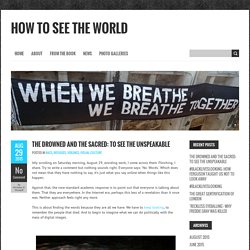
Flinching, I share. Try to write a comment but nothing sounds right. Everyone says: ‘No. Words.’ Against that, the now-standard academic response is to point out that everyone is talking about them. This is about finding the words because they are all we have. From “Multicultural Graveyard” by Khaled Barakeh I’m looking at a set of photographs posted to Facebook (taken down by Facebook admins on August 30) by the Syrian photographer Khaled Barakeh.
Barakeh tells us Last night [August 28, 2015] more than 80 Syrians and Palestinians refugees have drowned in the Mediterranean close to the Libyan shores trying to reach Europe. Whether he took these pictures or found them elsewhere, he doesn’t say. There are seven photographs altogether. Barakeh calls the sequence Multicultural Graveyard. Shattered Beauty exhibition of Syrian art - in pictures. Hamid Sulaiman. Hamid Sulaiman is a Syrian painter and artist from the Damascus suburb of Zabadani – an area that is known for its nonviolent, civil participation in the Syrian revolution, and for the distinct banners raised by activists at demonstrations.
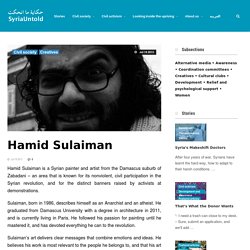
Sulaiman, born in 1986, describes himself as an Anarchist and an atheist. He graduated from Damascus University with a degree in architecture in 2011, and is currently living in Paris. He followed his passion for painting until he mastered it, and has devoted everything he can to the revolution. Sulaiman’s art delivers clear messages that combine emotions and ideas. He believes his work is most relevant to the people he belongs to, and that his art portrays a bias toward the suffering of poor people like himself. Here and Elsewhere. The exhibition brings together more than forty-five artists from over fifteen countries, many of whom live and work internationally.
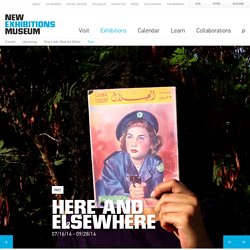
In keeping with the New Museum’s dedication to showcasing the most engaging new art from around the globe, “Here and Elsewhere” is the most recent in a series of exhibitions that have introduced urgent questions and new aesthetics to US audiences. “This exhibition continues the New Museum’s commitment to looking at art from beyond the confines familiar to the New York art world,” said Massimiliano Gioni, Associate Director and Director of Exhibitions. Muzaffar Salman. Photographe pour Associated Press puis, depuis 2013, pour Reuters, Muzaffar Salman se rend régulièrement en Syrie pour couvrir l’actualité.

Depuis les débuts du conflit, ses images imprègnent de poésie et d’espoir les situations les plus désespérées. ” Même si j’ai passé l’année dernière à cou- vrir la guerre à Alep pour Reuters, il m’est toujours aussi impossible de me considérer à proprement parler comme un reporter de guerre. Au milieu d’une scène de guerre, ma lentille traque la beauté, prête à cap- turer les détails et les instants de grâce. Les scènes magnifiques sont réelles, et le sont au-delà des ravages de la guerre. In Place of War. Syrian artist's work references war. Artist Issam Kourbaj talks about his latest work inspired by his Syrian homeland. Untitled. A Berlin, le cri d'alarme des artistes syriens. Issam Kourbaj - Excavating The Present. Issam Kourbaj - Another Day Lost. Download Syria Speaks: Beau Bothwell Speaks to Malu Halasa and Zaher Omareen 0:50:01 172139879 Lagu MP3 Gratis.
Malu Halasa and Zaher Omareen are two of the editors of Syria Speaks: Art and Culture from the Frontline.
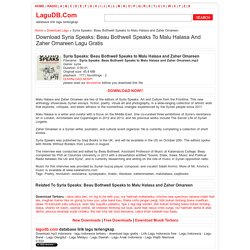
This new anthology showcases Syrian essays, fiction, poetry, visual art and photography, in a wide-ranging collection of artistic work that explores, critiques, and bears witness to the momentous changes experienced by the Syrian people since 2011. Malu Halasa is a writer and curator with a focus on the Middle East. Sulafa Hijazi. Syrian writer, director and artist Sulafa Hijazi was the first female director of animated film in Syria.
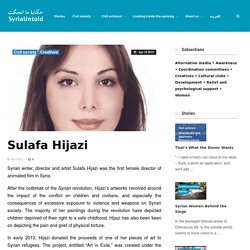
After the outbreak of the Syrian revolution, Hijazi’s artworks revolved around the impact of the conflict on children and civilians, and especially the consequences of excessive exposure to violence and weapons on Syrian society. The majority of her paintings during the revolution have depicted children deprived of their right to a safe childhood. Behind every Scar: A Story By Aviva Kaminer. On Khaled Barakeh’s Works ‘Regarding the Pain of Others’ and ‘Damascus 15/02/2012 19:47:31' By Aviva Kaminer Khaled Barakeh’s Regarding the Pain of Others and Damascus 15/02/2012 19:47:31, exhibited for the first time in Frankfurt in 2013, represent a sensitive and intelligent engagement with an ongoing violent conflict that is broadcast or live- streamed into our day-to-day reality through television and social media such as Facebook or Twitter.
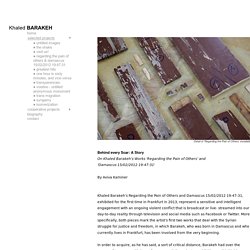
More specifically, both pieces mark the artist’s first two works that deal with the Syrian struggle for justice and freedom, in which Barakeh, who was born in Damascus and who currently lives in Frankfurt, has been involved from the very beginning. Behind every Scar: A Story By Aviva Kaminer. Behind every Scar: A Story By Aviva Kaminer. Regarding the Pain of Others & Damascus. Showreel_Madonna adib. Un passeport devenu tableau, pour exprimer le calvaire des Syriens. Le jeune artiste syrien Rabee Kiwan présente ses dernières œuvres à la Galerie Lab 44 à Paris.
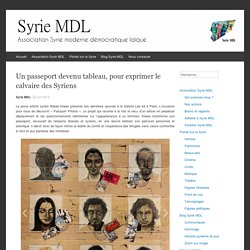
L’occasion pour nous de découvrir « Passport Photos », un projet qui raconte à la fois le vécu d’un artiste en perpétuel déplacement et les questionnements identitaires sur l’appartenance à un territoire. Kiwan transforme son passeport, recouvert de tampons libanais et syriens, en une œuvre relatant son parcours personnel et artistique. Il décrit ainsi de façon intime la réalité du conflit et l’expérience des réfugiés sans cesse confrontés à l’exil et aux barrières des frontières. La série de tableaux « photos personnelles » regroupe des portraits de face tirées des photos d’identité de passeports de quelques amis et de l’artiste lui-même. Le sienne est quadrillée, fragmentée en mille morceaux. L’artiste : Rabee Kiwan est né en 1984 à Damas en Syrie. Exposition du 4 au 24 juin à la Galerie Lab 44.
Par Racha Abazied. Beyond Exile: Hrair Sarkissian’s Homesick. Nafas Art Magazine. Beyond Exile: Hrair Sarkissian’s Homesick By Murtaza Vali | January 2015 Exile is predicated on the existence of, love for, and bond with, one’s native place; what is true of all exile is not that home and love of home are lost, but that loss is inherent in the very existence of both.Edward Saïd, Reflections on Exile [1] A scale model of a non-descript muddy brown apartment block, of the sort commonly found in cities across the Middle East, fills the photograph’s frame, the first of a series of five large-scale images that form a part of Hrair Sarkissian’s latest project, Homesick (2014).
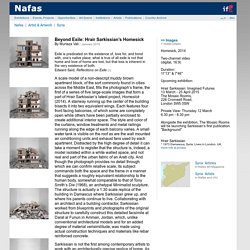
A stairway running up the center of the building bisects it into two equivalent wings. News Art Market Books Comment Miami’s art museums are becoming rudderless ships Free Nearly half the city’s institutions are without leaders as powerful patrons, unruly trustees, funding issues and rivalries between ethnic groups make the waters nearly impossible to navigate Conservation Exhibitions Fairs Auctions Features The verdict that flies in the face of art history.
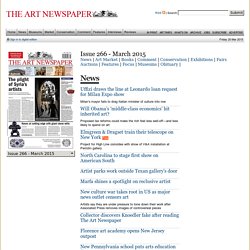
Tammam Azzams version of 001.